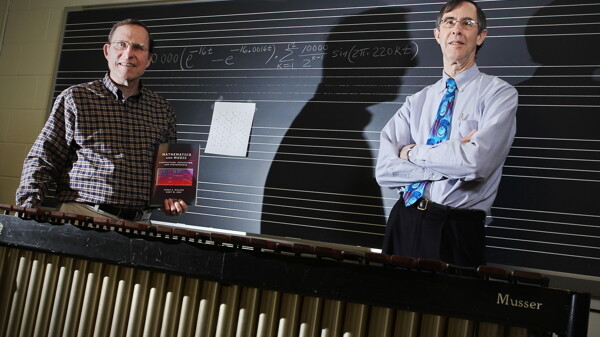The Geometry of Harmony
UWEC profs meld math, music in new textbook
Rachel Mickelson, photos by Andrea Paulseth |

Music lovers might be surprised to find that Art Garfunkel holds a masters of arts in mathematics. Even Einstein claimed that he saw his life “in terms of music” and that if he hadn’t been a physicist, he surely would have been a musician. It turns out math and music – although seemingly different worlds – are similar languages that can be used to understand and describe one another.
In their recently published textbook, Mathematics and Music: Composition, Perception, and Performance, UW-Eau Claire’s James Walker, professor of mathematics, and Gary Don, associate professor of music and theatre arts, team up to reveal the complementary nature of the two disciplines.
“I think as teachers, we’re trying to find something that students can get interested in.” – Gary Don, associate professor of music and theatre arts at UW-Eau Claire, on making the academic link between math and music
A result of more than a decade of collaborative research, the book focuses on the mathematics of musical scales; the graphical depiction of pitches and overtones (spectrograms) and how they aid interpretation of musical performance; the comparative graphical analysis of rhythm sequences in world music; the geometric interrelation of chord changes; and how mathematics can be used in audio synthesis for creating new music.
The book will be used as the official textbook for Walker’s “Mathematics and Music” course. According to the duo, the class is aimed at providing a relevant platform for students by allowing them to apply their own musical tastes to mathematical concepts.
“Anything to relieve the tedium of math class is welcome!” Walker laughs. In class, students analyze all genres of music from pop to opera, classical to jazz.
“I think as teachers, we’re trying to find something that students can get interested in,” Don says. “It’s a big tool for engagement which means students are going to be more receptive and they’re going to do better work.”
The two also add that UW-Eau Claire, hailed for its successful student-faculty research program as well as its musical prowess, is a prime atmosphere for the course to thrive. Pedagogically tried-and-true, their book draws from five years worth of lecture notes and even includes impressive contributions from the students themselves.
“Many students here are involved with music, and how much they know,” Walker says. “You always hear professors say they learn so much from their students, and I have learned a great deal from them. There’s a number of examples in the book that simply would not have been there if I hadn’t taught the course and had these students.”
The duo’s interdisciplinary teamwork mirrors the valued collaboration between faculty and students at UW-Eau Claire. In fact, the professors’ friendship took root when a student’s double major in mathematics and music inspired her to embark on a research project.
“The student-faculty research program is strongly supported here, and that’s not true everywhere,” Don says. “That was the spark that got the whole thing started, but I also think there’s an interest now in interdisciplinary work between faculty. It’s about getting students involved in research, which has been a strength for a long time, but also encouraging faculty to go beyond our disciplines and look at connections to other disciplines.”
Walker and Don’s initial research that shaped the content of the book was featured in the January 2010 issue of the prestigious mathematics journal Notices of the American Mathematical Society. To find out more about their textbook or the course, visit the class’s supplementary website at www.uwec.edu/walkerjs/mathematicsandmusic/.
To view visual representations of a variety of musical genres, check out Walker’s spectrogram videos at http://tinyurl.com/btaxtks.




















